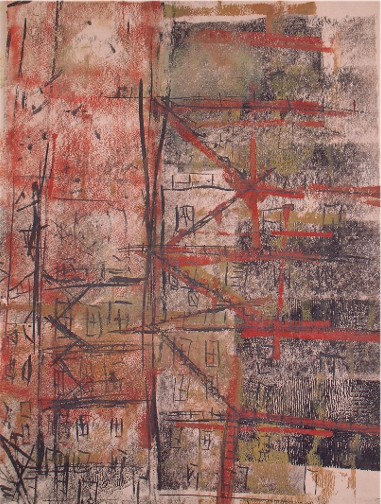
First Manhattan Portrait 1958
| |
My process of "Painting Into The Print" got a very early start. When working on the first "Manhattan Portraits" 1958, I used several Linoleum prints as a start. I painted into the print extensively and then used part of the matrix, (by only inking a few spots) to echo the shapes. Later when studying the Italian 13th & 14th Century masters I learned that they made extensive use of pattern printing and stamping as part of their work. One of the variations in the "Manhattan Portraits" process was to use the brayer, a soft faced roller, picking up uneven multi color ink spots from the glass and rolling directly on the painting. Then using the same ink pattern to load the matrix and reprint. "Printing Into The Painting."
The point of all the variations created by interrupting both the
painting and printing process is to achieve cross-pollination. I first
heard the term cross-pollination in art and learning from Jack Tworkove
at the Yale School Of Art many years later. In short the
cross-pollination enhances the language of the image. It offers a wider
diverse source which entices the eye into a new interpretation. A new
way of making, a new way of seeing. There is a point here. Tradition
in art when adhered to as a strict method, only produces imitations
of a successful product line. An old product line. The creativity of
any given age, is in the departure from "was" to "can be."
An illustrator who I met in New York explained that he used a strict unchanging process. The work he did had no relevance in it's physicality. It was a stepping stone in making a photograph. The photograph became the matrix in offset printing which made a magazine. I started painting into photographs as a desire for color. My first camera was a Brownie. The grayscale of my early photos needed a little help. Later when studying Venetian and Flemish glazing methods I realized they also developed a similar process. A series of oil paintings I experimented with adapted these influences. They started with completing a grayscale under painting and then layering glazes to render subtle coloring. Another method of grayscale painting was based on the 14th Century cartoon. A gray tinted ground was worked into with black ink. Semi-tones of gray to white established volume. Then glazes offered the suggestion of color.
The subject of photography influencing painting and the physicality of art is a subject of long discussions I had with Alfred Leslie. He came from an abstract expressionist attitude in his art to his own realism. One of his observations was that realism came to the rescue of art when it lost direction. He also felt that photography of European masters work heavily influenced the abstract expressionists. The glorification of the detail with close up photographs, presented the brush work as monumental. These were very interesting observations. In his own realism works the detail of his brush work remains dynamic. My own relationship with brush and image is to play off the mark as a quotation of abstraction, within the representation. When doing a completely abstract work, my marks become elements in their own universe.
|
| |
| |
© 2008 Odysseus Publications
|
|

 Painting Into The Print
Painting Into The Print

 Painting Into The Print
Painting Into The Print